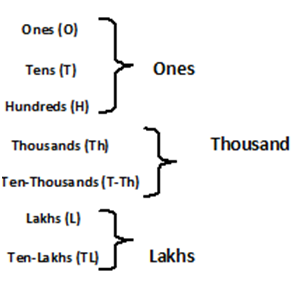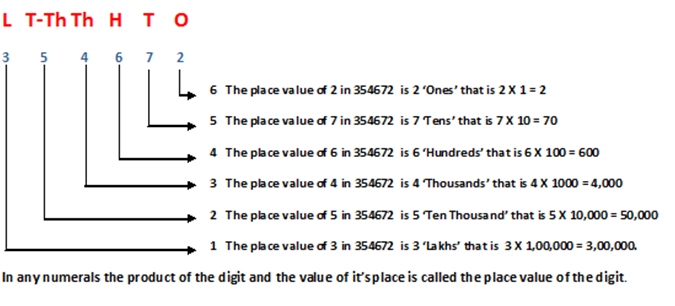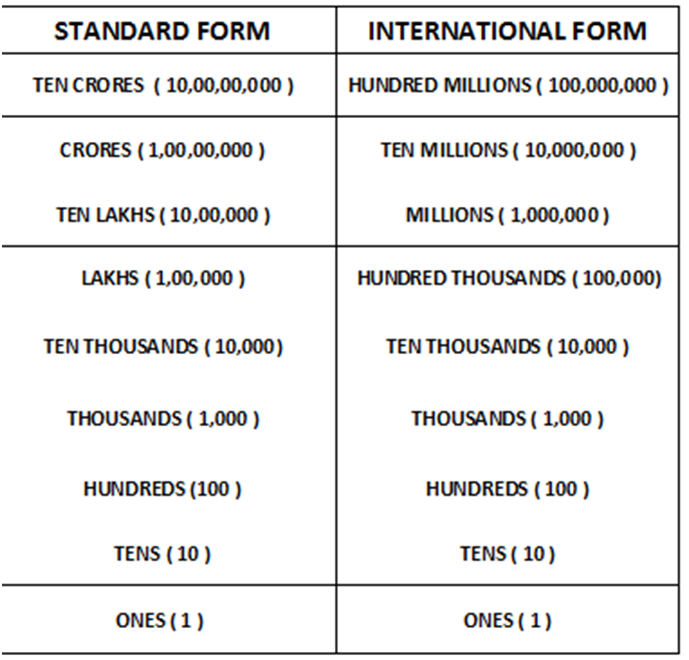CLASS-4
PLACE VALUE & FACE VALUE
PLACE VALUE
The place value of a digit is nothing but a position of a number. On depends on the position of numbers place value is decided. If digit moves right to left then the value of digit increases. If digit moves left side, by every movement value of the same digit will increase by 10 times.
Dear All, now you all know ‘The smallest place is on the extreme right and every move from right towards left the value of a number increase by 10 times than present value.
Ten-Lakhs - (TL) - 10,00,000
Lakhs - (L) - 1,00,000
Ten-Thousands - (T-Th) - 10,000
Thousands - (Th) - 1,000
Hundreds - (H) - 100
Tens - (T) - 10
Ones - (O) - 1
TL L T-Th Th H T O
10,00,000 1,00,000 10,000 1,000 100 10 1
To read and write easily we now learn about Periods. Place is divided by Periods. Details are given below –

a) The period of Ones consists of three places – Ones , Tens , Hundreds.
b) The period of Thousands consists of two places – Thousands , Ten-Thousands.
c) The period of Lakhs consists of two places – Lakhs , Ten-Lakhs.
By this period we can understand, read & write the number name.
Suppose there are some number you have to describe, these are –
a) 2542529 , b) 834562 , c) 75321
TL L T-Th Th H T O
a) 2 5 4 2 5 2 9
above number line can be described in number name as like as 25 lakhs 42 thousands 5 hundred 29 ( No ‘And’ should be used between Hundreds and Ones ) and to show the period in a number, commas are used, i.e. 25, 42, 529.
TL L T-Th Th H T O
b) 8 3 4 5 6 2
above number line can be describe in number name as like 8 lakhs 34 thousand 5 hundred 62 ( No ‘And’ should be used between Hundreds and Ones ) and to show the period in a number, commas are used, i.e. 8,34,562 .
TL L T-Th Th H T O
c) 7 5 3 2 1
above number line can be described in number name as 75 thousand 3 hundred 21 ( No ‘And’ should be used between Hundreds and Ones ) and to show the period in a number, commas are used, i.e. 75,321.

EXPANDED NUMERALS
a) Expanded notation/numeral means to expand each digit of a numeral to its full form or place value and write their sum total.
b) You have learned that, the place value of any digit in a numerals is the product of the digit and the value of its place.
Suppose there is a number i.e. 3526439 which we have to expand –
Q.1) 3526439 = 35,26,439 (Remember you have to mark the period first)
There are three different processes to describe the above number –
1st Process = (3 x 10,00,000) + (5 X 1,00,000) + (2 X 10,000) + (6 X 1,000) + (4 X 100) + (3 X 10) + (9 x 1)
2nd Process = 3 Ten-Lakhs + 5 Lakhs + 2 Ten-Thousands + 6 Thousands + 4 Hundreds + 3 Tens + 9 Ones.
3rd Process = 30,00,000 + 5,00,000 + 20,000 + 6,000 + 400 + 30 + 9.
Q.2) 7856759 = 78,56,759 ( remember you have to mark the period first )
There are three different processes to describe the above number –
1st Process = (7 x 10,00,000) + (8 X 1,00,000) + (5 X 10,000) + (6 X 1,000) + (7 X 100) + (5 X 10) + (9 x 1)
2nd Process = 7 Ten-Lakhs + 8 Lakhs + 5 Ten-Thousands + 6 Thousands + 7 Hundreds + 5 Tens + 9 Ones.
3rd Process = 70,00,000 + 8,00,000 + 50,000 + 6,000 + 700 + 50 + 9.
Q.3) 409568 = 04,09,568 (remember you have to mark the period first )
There are three different processes to describe the above number –
1st Process = (4 X 1,00,000) + (9 X 1,000) + (5 X 100) + (6 X 10) + (8 x 1)
2nd Process = 4 Lakhs + 9 Thousands + 5 Hundreds + 6 Tens + 8 Ones.
3rd Process = 4,00,000 + 9,000 + 500 + 60 + 8.
STANDARD & INTERNATIONAL PLACE VALUE CHART

In standard period form-
1) Ones, Tens and Hundreds are belonged to ‘Ones’ period
2) Ten-Thousands and Thousands are belonged to ‘Thousands’ period
3) Ten-Lakhs and Lakhs are belonged to ‘Lakhs’ period
4) Ten-Crores and Crores are belonged to ‘Crores’ period.
In International period form-
1) Ones, Tens and Hundreds are belonged to ‘Ones’ period
2) Hundred-Thousands,Ten-Thousands and Thousands are belongs to ‘Thousands’ period
3) Hundred-Millions, Ten-Millions and Millions are belong to ‘Millions’ period.
There are some other ways of learning about place value & face value are given below which will definitely help you to build confidence about place value & face value.
a) Indian Place Value Table & Their Rules,
b) Write The Number Using Place Value Table,
c) Relation Between Place Value & Face Value,